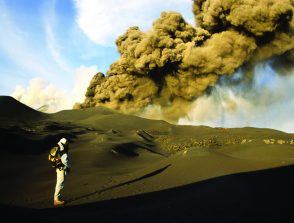Insights into dike nucleation and eruption dynamics from high-resolution seismic imaging of magmatic system at the East Pacific Rise
26/04/2024
IPGP - Îlot Cuvier
14:00
Séminaires thème Risques naturels
Salle 310
Milena Marjanovic
IPGP
In volcanic systems, rupture to the surface leading to eruptions is primarily governed by processes within the shallow part of the magma plumbing system with conduits, including dikes, nucleating from and tapping the shallow-level magma bodies. Where and how dikes nucleate from these magma accumulations to breach the layer above and erupt are subjects of ongoing debate of central importance for understanding volcano evolution and hazard assessment. Numerical models indicate that the geometry of magma bodies play an important role in dike nucleation and eruption triggering. However, due to the general inaccessibility of most active volcanic systems to high-resolution imaging, only the large-scale general morphology of these magma reservoirs is known leading to conceptualizations of smooth bodies with simple geometric shapes. Obtaining a detailed architecture of the shallow magma system from which eruptions are staged is important for evaluating end member models for eruption triggering and for understanding what controls the location, style, and frequency and duration of volcanic eruptions. Mid-ocean ridges host the most extensive magmatic system on Earth, with 98% of its length below the ocean surface, which makes them an ideal target to be scanned by controlled-source marine seismic techniques. Beneath some portions of this vast system, the shallowest magma bodies are present and represented by long-linear Axial Magma Lenses (AML). It is at these shallow-most AMLs where dikes nucleate and connect the magma accumulations to the surface to result in an eruption. To explore the magma plumbing systems at mid-ocean ridges, we use 3-D multichannel seismic data across a mid-ocean ridge environment and apply advanced marine seismic techniques to develop the highest resolution reflection images of the AMLs so far. The data were collected across a magmatically dynamic portion of the East Pacific Rise at 9°50’N with documented dike intrusion and eruptions in 1991/1992 and 2005/06. The obtained ultra-high-resolution images reveal that shallow magma accumulations are not smooth bodies but rather display prominent ridges and troughs that we interpret as remanent dike root zones where repeat dikes nucleate due to topography-induced stress concentrations. In the detailed topography, we find evidence for: 1) a dike root zone beneath where a caldera-like axial eruptive fissure zone is present, 2) deep excavation of this root zone within the primary eruption site for the last documented eruption, and 3) dikes rupturing from edges as well as the center of magma lenses. The results demonstrate that the distribution of additional, off-axis crustal magma accumulations further impact the stresses and melt budget at shallow-level magma accumulations leading to more frequent eruptions and argue for the bottom-up triggering mechanism. Considering the fine-scale morphology of shallow magma bodies will be critical for future generations of more realistic numerical models to aid in effective global volcanic hazard assessment and mitigation.




